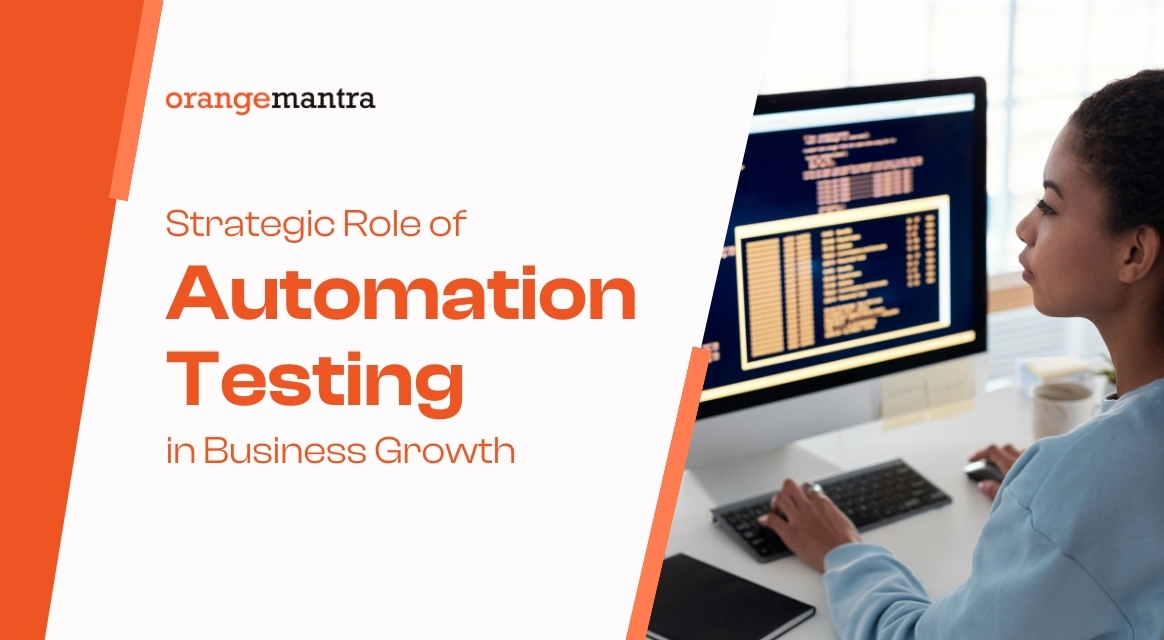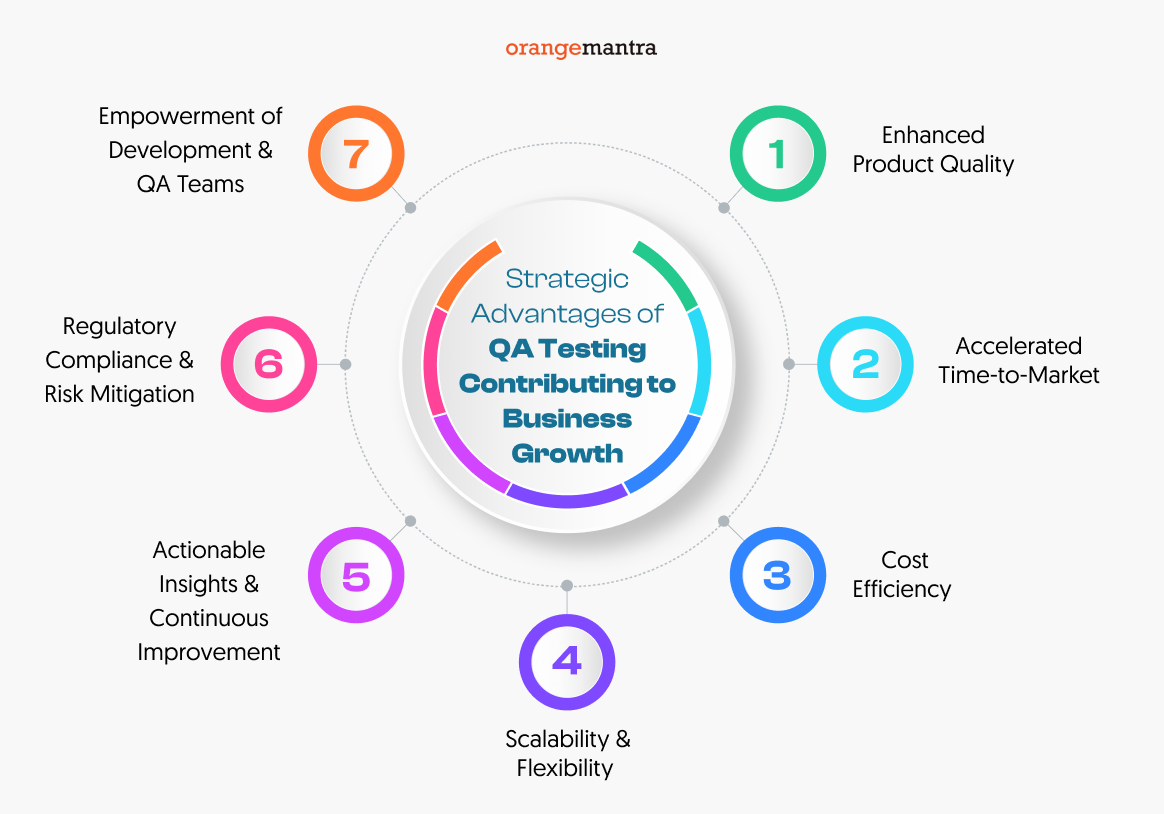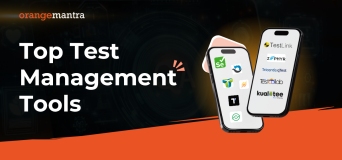
Here’s what you will learn:
This rapidly evolving technological world is making businesses to strive continuously to enhance their competitiveness, agility and efficiency. Among this dynamic environment, the role of automation testing is to ensure product quality and driving sustainable business growth.
It has emerged as a critical component in the realm of software development and quality assurance. Businesses are under increasing pressure to deliver high quality software products quickly and efficiently. Software testing offers solution to streamlining the process, reducing manual effort, and improving overall product quality.
Its core software testing involves using specialized software tools to execute pre-scripted tests on software applications, comparing actual outcomes with predicted outcomes, and reporting the results. However, manual testing mainly relies on human intervention to perform tests. Automation Testing leverages scripts and test frameworks to automate repetitive tasks, such as regression testing, functional testing, and performance testing.
Table of Contents
How Our Automation Testing Services Can Improve The Development Process?
Our automation testing services are designed to enhance the efficiency, reliability, and quality of your software development process. Our solutions encompass every aspect of automation testing, from strategy to test execution ensuring thorough validation of software products. Here’s a closer look at the automation testing services we provide:
Test Automation Strategy Development
Our experts assess your existing testing processes, identify automation opportunities. And define a roadmap to maximize the benefits of automation testing.
Testing Environment Setup & Configuration
We handle the setup and configuration of testing environments, ensuring that they accurately replicate production environments for comprehensive testing. By creating standardized, reproducible testing environments, we minimize inconsistencies and ensure reliable test results.
Automated Test Data Generation
Generating test data manually can be time-consuming and error-prone. With our automated test data generation solutions, we streamline the process of creating diverse and realistic test datasets. Thus, enabling more thorough testing coverage and accurate validation of your software.
Automated UI Testing
Our automated UI testing services leverage leading frameworks and tools to automate the validation of your application’s user interface. By simulating user interactions and verifying UI elements, we ensure functionality, and usability of your application across different devices.
API Testing
API testing is essential for validating the functionality, reliability, and performance of your application’s APIs. Our Automation testing encompass a range of tests, including functional testing, security testing, and performance testing services, to ensure that your APIs meet the desired standards and specifications.
AI Enabled Automated Regression Testing
With the integration of artificial intelligence (AI) technologies, we enhance the efficiency and effectiveness of regression testing. Our AI-enabled regression testing solutions intelligently identify regression issues, prioritize test cases, and optimize test execution. This enables faster feedback and more reliable results.
Why Our Automation Testing Leads the Way?
OrangeMantra a renowned software testing company is the preferred choice of many organizations for automation testing. With a team of experts, we offer specialized knowledge and skills to ensure thorough testing coverage and accurate results.
Our approach to automation testing is highly customizable, tailored to your project goals, timeline, and budget constraints. We prioritize comprehensive test coverage, encompassing functional testing, integration testing, and UI testing, among others, to ensure the flawless performance of your software across various platforms and devices.
With rapid test execution capabilities, we expedite testing cycles without compromising accuracy, enabling you to accelerate time-to-market for your software releases. Our transparent and proactive approach fosters collaboration and ensures that you remain in control of your project’s testing efforts.
Additionally, our software testing services are scalable and flexible, accommodating projects of all sizes and complexities, while delivering cost-effective solutions that maximize your return on investment. With us as your automation testing partner, you can trust us to deliver superior testing solutions that drive business value and innovation.
Emergence of Automation Testing
The adoption of automation testing has grown significantly in recent years. This is driven by the need for faster release cycles, improved test coverage, and enhanced accuracy.
By automating routine testing procedures, businesses can accelerate the development process, identify defects early, and deliver more reliable software products to market.
Evolution of Automation Testing
The journey of Automation Testing has been marked by significant evolution and innovation, driven by advancements in technology and the changing demands of the software development industry. Over the years, Automation Testing has evolved from simple record-and-playback tools to sophisticated frameworks capable of handling complex testing scenarios across diverse platforms and environments.
- In early days, record-and-playback tools automation testing traces its roots back to the early days of software development when record-and-playback tools emerged as the first-generation automation solutions.
- These tools allowed testers to record their interactions with the software application and replay them to automate repetitive test cases. While these tools offered some degree of automation, they were limited in functionality and lacked robustness.
- As the demand for more powerful testing capabilities grew, testers began to explore the use of scripting languages, such as Perl, Python, and Shell scripting, to create custom automation scripts.
- This marked the second phase in the evolution of Testing Services, characterized by greater flexibility and control over the testing process. Software Testers could now write custom scripts to automate complex test scenarios and integrate with other tools and systems.
- The next significant milestone in the evolution was the introduction of commercial test automation tools by software vendors.
- The tools, such as HP QTP (now UFT), Selenium, and IBM Rational Functional Tester, offered comprehensive automation capabilities along with features like object recognition, data-driven testing, and reporting.
- They provided a more structured approach to test automation, enabling organizations to scale their testing efforts and improve test coverage.
Take the step towards seamless software development with our Automation Testing
The Shift Towards Open-Source Automation Testing
With the growing popularity of open-source software, there was a noticeable shift towards open-source Automation Testing frameworks like Selenium WebDriver, Appium, and Robot Framework. These frameworks offered powerful automation capabilities along with the flexibility and cost-effectiveness of open-source solutions. They gained widespread adoption within the testing community and became the de facto standards for Automation Testing across web, mobile, and desktop applications.
Integration of Automation Testing with Agile and DevOps Practices
In recent years, Automation Testing has become an integral part of DevOps practices, facilitating continuous testing and seamless integration with the software development lifecycle.
- Automation Testing frameworks have evolved to support agile development methodologies, enabling teams to automate tests early in the development process, run tests in parallel, and provide rapid feedback on code changes.
- This alignment with DevOps principles has led to greater collaboration between development and testing teams and accelerated the pace of software delivery.
Innovation in Automation Testing
With the emergence of AI and Machine Learning in Testing, the future of Testing is likely to be shaped by advancements in artificial intelligence (AI) and machine learning (ML) technologies. AI-powered testing tools are already making waves in the industry, offering capabilities such as intelligent test case generation, predictive analytics, and autonomous test execution.
Further, these technologies have the potential to automate testing processes, improve test accuracy, and enable organizations to keep pace with the evolving landscape of software development.
Now let’s discuss the role of Automation Testing frameworks in driving business growth and explore how these frameworks empower organizations to optimize their testing efforts to achieve their strategic objectives.
Strategic Advantages of QA Testing Contributing to Business Growth
Automation testing frameworks serve as the backbone of software development and quality assurance processes by automating the execution of test cases, thereby reducing manual effort, minimizing human errors, and enhancing overall testing efficiency. Here are some factors that contribute to growth trajectory:
- Enhanced Product Quality
Automation testing frameworks enable comprehensive test coverage across diverse platforms, devices, and environments, ensuring robustness, reliability, and consistency in product performance. These frameworks facilitate the early detection of defects and vulnerabilities by conducting repetitive tests with precision and accuracy. As a result, preemptively addressing potential issues before they escalate.
Consequently, businesses can deliver high-quality products that resonate with customer expectations, thereby bolstering brand reputation and loyalty.
- Accelerated Time-to-Market
In today’s fiercely competitive market, time-to-market plays a pivotal role in determining business success. Automation testing frameworks expedite the testing process by swiftly executing test cases across various scenarios, thereby significantly reducing the testing lifecycle.
This accelerated testing timeline enables businesses to streamline their development cycles, meet aggressive project deadlines, and swiftly introduce innovative solutions to the market, gaining a competitive edge and seizing market opportunities ahead of rivals.
- Cost Efficiency
Manual testing processes entail substantial resource allocation in terms of time, effort, and workforce. Automation testing frameworks mitigate these resource overheads by automating repetitive testing tasks, thus optimizing resource utilization and minimizing operational costs.
Additionally, automation frameworks facilitate regression testing, allowing businesses to detect regressions promptly without incurring additional expenses associated with manual testing efforts. Businesses can allocate resources strategically towards innovation and growth initiatives which optimizes testing expenditures and maximize ROI and drive sustainable profits
- Scalability and Flexibility
Automation testing frameworks offer scalability and flexibility to adapt to evolving project requirements and dynamic market demands seamlessly. These frameworks empower businesses to orchestrate complex testing scenarios, accommodate scalability needs, and support integration with diverse tools and technologies.
Moreover, automation frameworks facilitate parallel test execution, enabling efficient utilization of computing resources and expedited testing cycles, thereby catering to the scalability needs of growing businesses without compromising on quality or performance.
- Actionable Insights and Continuous Improvement
Automation testing frameworks provide actionable insights into test results, performance metrics, and defect trends, enabling stakeholders to make informed decisions and drive continuous improvement initiatives.
With advanced analytics and reporting capabilities offered by automation frameworks, businesses can gain deeper visibility into product quality, identify bottlenecks in the development lifecycle, and implement targeted remediation strategies. This data-driven approach fosters a culture of continuous improvement, agility, and innovation, propelling business growth and resilience in a rapidly evolving marketplace.
- Regulatory Compliance and Risk Mitigation
Compliance with industry regulations and standards is paramount for businesses operating in regulated sectors such as healthcare, finance, and cybersecurity. Software testing facilitate robust test case management, documentation, and traceability, ensuring adherence to regulatory requirements and mitigating compliance risks. By automating compliance testing processes, businesses can demonstrate due diligence, enhance audit readiness, and safeguard against potential legal and reputational repercussions, thereby fostering trust and credibility among stakeholders.
- Empowerment of Development and QA Teams
Automation testing frameworks empower development and QA teams with tools, resources, and frameworks to collaborate effectively, streamline workflows, and drive innovation. These frameworks facilitate cross-functional collaboration, knowledge sharing, and skill development, thereby fostering a culture of teamwork, accountability, and excellence. By empowering teams to focus on value-added tasks and strategic initiatives, automation frameworks unleash their creative potential and drive business growth through continuous innovation and differentiation.
Transform your Software Testing Process and Drive Success with our QA Testing
Key Strategies for Successful Automation Testing
Automation Testing can significantly improve efficiency, reduce time-to-market, and enhance the quality of software products when implemented strategically. However, to avail its full benefits organizations need to adopt effective strategies tailored to their specific needs and objectives. Here are some key strategies for successful Automation Testing:
Define Clear Objectives
Foremost, it’s essential to define clear objectives and scope for your automation efforts. Identify the types of tests that are suitable for automation, such as regression testing, smoke testing, and repetitive manual tasks.
Determine the goals you want to achieve through automation, such as increasing test coverage, improving test accuracy, or reducing testing cycle time. Having a well-defined scope will help focus your automation efforts and ensure that you derive maximum value from your investment.
Select the Right Automation Tools and Frameworks
Choose automation tools and frameworks that align with your technology stack, software testing requirements, and budget constraints. Evaluate different options based on factors such as ease of use, scalability, integration capabilities, and community support.
For web application testing, popular tools like Selenium WebDriver and Cypress.io are widely used. Similarly, for mobile application testing, tools like Appium and XCTest are popular choices. Consider factors such as cross-browser compatibility, support for different programming languages, and the availability of plugins and extensions when selecting automation tools.
Establish Robust Test Automation Architecture
Design a robust test automation architecture that facilitates scalability, maintainability, and reusability of test assets. Adopt a modular approach to test automation, where tests are broken down into smaller, reusable components or modules.
Use design patterns like Page Object Model (POM) or Screenplay Pattern to create a clean separation between test logic and application UI. Implement a centralized test automation framework that provides features such as test data management, reporting, and integration with CI/CD pipelines.
Prioritize Test Cases for Automation
Not all test cases are suitable candidates for automation. Prioritize test cases based on factors such as frequency of execution, criticality, and complexity. Start by automating high-impact test cases that cover critical functionality and are executed frequently during the software development lifecycle.
Focus on automating repetitive tasks that are time-consuming when performed manually, such as regression testing, data-driven testing, and cross-browser testing. Gradually expand test automation coverage as your automation maturity grows.
Invest in Test Data Management and Environment Setup
Ensure that you have a reliable test data management strategy in place to provision and maintain test data for automated tests. Use techniques such as data masking, synthetic data generation, and test data provisioning tools to create realistic test data sets.
Similarly, invest in setting up and managing test environments that closely resemble production environments to ensure accurate test results. Implement infrastructure-as-code (IaC) practices to automate the provisioning and configuration of test environments using tools like Docker, Kubernetes, or cloud-based services.
Integrate Automation Testing into CI/CD Pipelines
Integrate Automation Testing seamlessly into your CI/CD pipelines to enable continuous testing and rapid feedback on code changes. Automate the execution of automated tests as part of your build and deployment pipelines triggered by code commits or deployment events.
Use CI/CD tools like Jenkins, GitLab CI/CD, or Azure DevOps to orchestrate test execution, generate test reports, and track test results. Implement parallel test execution to reduce testing cycle time and accelerate feedback loops.
Monitor and Maintain Automation Suites
Regularly monitor the health and performance of your automation suites to ensure they remain effective and reliable. Establish metrics and KPIs to measure the effectiveness of automation efforts, such as test coverage, test execution time, and defect detection rate.
Monitor test execution results and analyze trends to identify areas for improvement and optimization. Maintain test automation scripts and frameworks by updating them to accommodate changes in the application under test, technology stack, or testing requirements.
Promote Collaboration and Knowledge Sharing
Foster collaboration and knowledge sharing among cross-functional teams involved in Automation Testing, including developers, testers, and QA engineers. Encourage collaboration through regular meetings, workshops, and knowledge-sharing sessions where team members can discuss automation best practices, share lessons learned, and troubleshoot common issues. Leverage collaboration tools like Slack, Microsoft Teams, or Confluence to facilitate communication and collaboration among team members working on automation projects.
With these strategies, organizations can build a robust Automation Testing ecosystem that accelerates the delivery of high-quality software products, improves team productivity, and drives business growth.
Conclusion
The evolution of Automation Testing has been driven by a combination of technological innovation, changing industry dynamics, and the need for greater efficiency and reliability in software development. From humble beginnings as record-and-playback tools to sophisticated AI-driven testing solutions, Software Testing has come a long way, playing a crucial role in ensuring the quality and reliability of modern software applications.
In summary, automation testing frameworks play a pivotal role in driving sustainable business growth by enhancing product quality, accelerating time-to-market, optimizing costs, fostering scalability and flexibility, enabling continuous improvement, ensuring regulatory compliance, and empowering development and QA teams. QA testing enables businesses to navigate the complexities of the digital landscape with confidence, resilience, and agility, thereby unlocking new opportunities for innovation, expansion, and success in the global marketplace.




